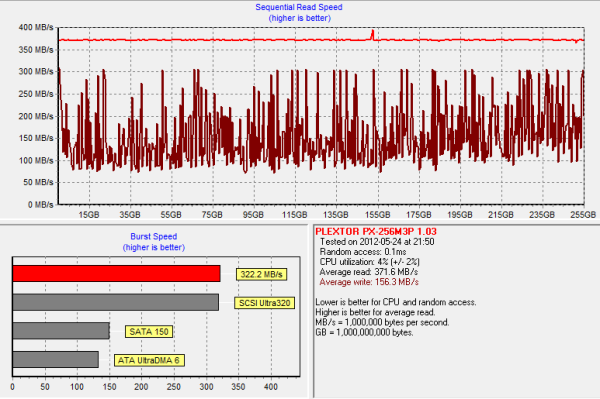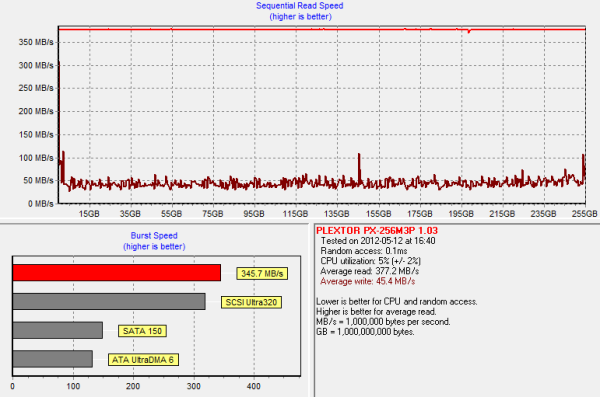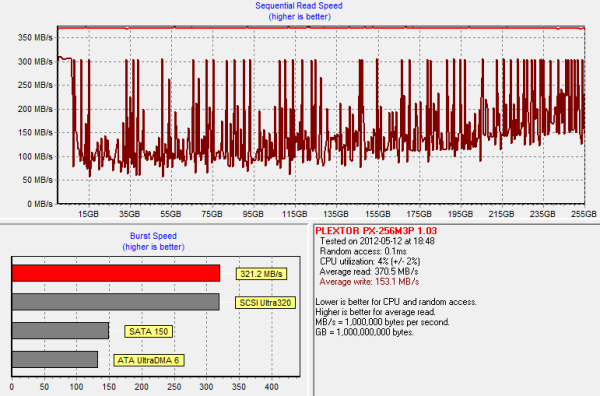Plextor M3 Pro (256GB) Review
by Kristian Vättö on July 1, 2012 1:45 PM ESTPerformance Over Time and TRIM
The M3 Pro is also equipped with Plextor's "True Speed" technology, which we found to be fairly effective when testing the M3. Hence we should expect the M3 Pro to do well in this aspect as well. To get the base-level performance, I ran HD Tach once on a clean drive:
The first step in our torture testing is 20 minutes of 4KB random writes (QD=32, 100% LBA space) ran on a full drive:
As with the M3, 20 minutes of torturing is nowhere enough to put the M3 Pro at its worst state. The average write performance is still 156MB/s, although it does drop to as low as 70-80MB/s for some LBAs.
Next I secure erased the drive and ran our torture test for 60 minutes:
And that's more like it. Average performance has dropped to 45MB/s and there are only three +100MB/s peaks. This was expected as the M3 experienced similar behavior.
I let the drive idle for an hour and 40 minutes after 60 minutes of torture and a single pass of HD Tach, and here's what the performance looked like:
Performance does recover pretty nicely with some idle time and sequential writes. Write speed is still nowhere near clean state performance but it has more than tripled when compared to the dirty state after 60 minutes of torturing.
Finally I TRIM'ed the drive to make sure that TRIM functions properly, and it does:
Overall the M3 Pro should be a good option, even if you're using an OS without official TRIM support (such as OS X). If you're running an OS with TRIM support, then there is obviously nothing to worry about as TRIM functions perfectly. TRIM can nowadays be enabled in OS X for third party drives as well, so there is even less to worry about. If you don't want to have TRIM enabled all the time (due to stability issues for example), you can enable it temporarily and TRIM the drive by secure erasing free space in Disk Utility. After that you can simply disable TRIM and you are left with a TRIM'ed SSD.















55 Comments
View All Comments
NCM - Monday, July 2, 2012 - link
Three things I forgot to include in my post above:- The Plextor needs to be reformatted for the Mac. You use Apple's Disk Utility to handle that, as with any other drive.
- Cloning the original drive using DU's Restore function will also automatically clone Lion's hidden Recovery partition.
- Absolute SSD performance is limited by my 2010 MBP's 3 Gb/s SATA interface, so I could have bought a cheaper last generation drive. However I hope to be keeping this pricey SSD long enough for it to see at least one more host computer, and that will support faster transfers.
Belard - Monday, July 2, 2012 - link
Pretty much ALL new SSDs are SATA3.0 / 6GB/s... so its not really an issue.Its older tech or mix tech models that are SATA2.
Kristian Vättö - Monday, July 2, 2012 - link
Not with the regular updater at least. In theory, someone could modify the installer and make it possible though.Kyanzes - Monday, July 2, 2012 - link
"relatively unknown brand" :)Okay.
bobsmith1492 - Monday, July 2, 2012 - link
Yes they are relatively unknown. Yes they used to be more well-known but only for optical drives.eanazag - Monday, July 2, 2012 - link
I would like to see a 2.5" HDD at 5400 rpm and 7200 rpm sample data for a baseline included in the reviews. I don't care if they ever get updated after that. I would just like to be able to quickly see where the mechanical drives chime in.Performance would data would be icing, but power data is nice.
If I upgrade my users to a drive off this list, which is very likely. I'd like to be able to tell them if they are going to take a hit on battery life or a boost.
Belard - Monday, July 2, 2012 - link
They stopped doing that some time ago because it messes up the charts somewhat. Basically, they just don't compare... and that was before the SATA 6Gbps drives came out.Here is a early 2011 review with a WD VelociRaptor (The fastest HD money can buy for a consumer drive). And yet, its a sliver. Only SSDs that perform almost as slow are the bottom end SSD. And keep in mind, the Raptors are 2-3 times faster than a 5400RPM drive.
http://www.anandtech.com/show/4346/ocz-agility-3-2...
RANDOM READ (MB/s)
00.68 = Raptor
58.10 = Intel X25-M G2 (still a very good drive)
93.50 = Crucial C300 (early 6Gbps drives)
Sequential READ (MB/s)
145.30 = Raptor
226.30 = Intel X25-M G2 (still a very good drive)
307.20 = Crucial C300 (early 6Gbps drives)
392.20 = Intel 510 SSD (6Gbps)
A modern high end SSD is about 100x faster in random R / W operations over any HD.
Oh, here is a GOOD older 2010 review which includes a Seagate 5400 RPM 2.5" drive. OUCH!
http://www.anandtech.com/show/3690/the-impact-of-s...
See how the chart becomes somewhat meaningless? And thats with 3Gbps drives!
Imagine looking at a chart comparing a 16mhz 286 to a quad core 3400mhz i5 CPU.
hechacker1 - Monday, July 2, 2012 - link
Probably, assuming there isn't some checksum that can't be cracked to flash the drive.In my experience, almost all drive firmwares can be flashed.
sulu1977 - Monday, July 2, 2012 - link
Speed and performance of such a device is important, but not as important as reliability. Reliability is hands down my top priority. Just wanted to mention this.octoploid - Tuesday, July 3, 2012 - link
There is already an unofficial tool available that can transform a normal M3 into an M3-Pro:http://bbs.pceva.com.cn/thread-47279-1-1.html